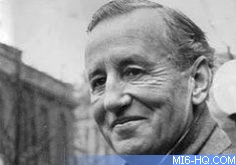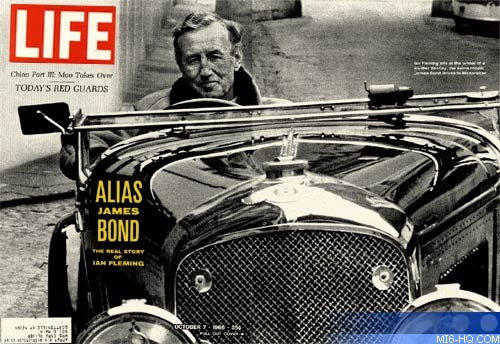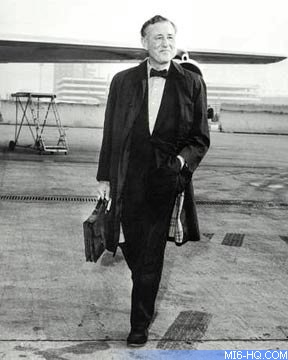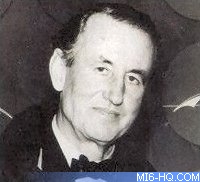 |
| |
MI6 looks back to October 1966 with America Life
Magazine, and what John Pearson had to say about Ian
Fleming.
|
|
Life Magazine - "Alias James Bond"
- The Real Story of Ian Fleming by John Pearson
25th April 2006
With the release of the fourth James Bond adventure on the silver
screen, the spy hype was at an all time high and the James Bond
producers and creators were under constant media scrutiny. In
October 1966, Life magazine published "The real story of
Ian Fleming", an
in-depth look at the life of the James Bond creator. Today, MI6
re-discovers what his friends and associates had to say about
Mr. Ian Fleming, in the height of the James Bond phenomenon.
Ian Lancaster Fleming, the second of four siblings, was brought
up in a stately Oxfordshire country home. It was clear from an
early age that Ian was to be "the difficult one". Growing
up he soon found and voiced his real dislikes: horses, dogs, and
family gatherings to name a few. It was clear he had no ear for
music, or interest in politics and his brother, Peter Fleming,
commented that Ian had "no feeling for land." It was
in 1914 that his father was sent to war, leaving his mother, Evelyn
St. Croix Fleming, to bring her four boys up alone. The next year,
their mother sent the two oldest, Peter and Ian, to Durnford School
on the isle of Purbeck.
 |
|
While at school, Ian received regular postcards from his
father, stationed in France. In April of 1917, the final
post card arrived and on the 20th of May, Major Valentine
Fleming was killed in action.
"When he wrote The Times'
obituary in You Only Live Twice for 'Commander James Bond,'
Ian Fleming recorded that Bond's career at Eton was 'brief
and undistinguished.' Fleming's was neither."
|
When Fleming turned 13, he was accepted to Eton. With strikingly
good looks and tall for his age, Fleming developed mannerisms
that would stay with him for the rest of his life. Brother Peter
was already attending Eton and Ian immediately felt out-classed
and shown-up by his elder brother. However, Ian dealt with this
in his own way - he never strived to be top-of-the-class or strongly
academic but he simply behaved as his slightly eccentric self.
"Rupert Hard-Davis, the publisher,
remembers him as 'something of a swell, walking down late for
breakfast of buttered eggs.'"
At his time at Eton, Fleming preferred to keep to himself but
when he did enter into discussion, acquaintances remarked on his
unique wit and turn of phrase. However, Ian's mother often received
reports of his poor work ethic and eventually agreed that Ian
should leave Eton to pursue a career in the military.
Fleming was sent to a Sandhurst school to prepare for the military
entrance examination. He passed 6th in the country. Before entering
the academy, Ian went abroad to Austria for further study at a
private school. The school was run by Ernan Forbes Dennis, who
encouraged Ian to participate in outdoor activities such as swimming,
skiing and mountaineering. When Fleming returned to Sandhurst,
he immediately realised he wasn't suited to the military and he
made no secret about it.
 Above: Front pull out cover of Life
Magazine - Issue October 7 - 1966 : Volume 61 Nuumber 15
Above: Front pull out cover of Life
Magazine - Issue October 7 - 1966 : Volume 61 Nuumber 15 |
"It was after a 'horrible experience
in the Cavalry school at Sandhurst' that Fleming said how profoundly
he 'agreed with whoever said that horses are dangerous at both
ends and uncomfortable in the middle.'"
When, inevitably, the life of a cadet didn't work out for Ian,
he returned to Ernan Forbes Dennis in Austria for study of topics
of his choice. Fleming found an interest in social history, anthropology
and history of science and technology and it was soon after returning
to the school that Phyllis Bottome, the wife of Forbes Dennis,
encouraged Fleming to pen his first short story - "Death
on Two Occasions".
"Years later … he referred to
those early days as 'the golden time when the sun always shone.'
He loved the Tyrol, the skiing, the climbing, the freedom. And
the girls."
1930 came and went and it was time for Ian to leave Austria and
make it on his own. He returned to his mother, and with her help
found a job at Reuters press agency. For a year he worked on in-office
tasks, but in 1933 Fleming was lucky enough to be asked to report
on the trial of six British engineers, taking place in Moscow.
On location, Fleming used his creative flare with words to write
his stories…
|
"He began a fill in story with
the knowledgeable line, 'When the big hands of Moscow's
300 electric clock reach the hour of six…' 'How do
you know there are 300?' asked another reporter. 'How do
you know there aren't?' said Fleming."
Ian impressed the officials at Reuters and was offered
further work reporting form Shanghai. But that August his
grandfather passed away, and to Ian's shock, he did not
stand to inherit any of his estate, valued at over $12 million.
This revelation prompted Fleming to leave Reuters and set
up business for himself, as a merchant banker. Together
with some friends, Fleming began a club he entitled the
"Circle". They had regular bridge nights and trips
to the golf club.
"Fleming took too many risks
to be a reliable bridge player… [A friend] remembers
Fleming trying to construct a complicated hand which was
later to figure in the bridge battle in Moonraker."
|
|

Above: Ian Fleming died on 12th August
1964, at the Royal St. George's Sandwich golf course in
Kent, suffering a heart attack.
|
After one failed engagement Fleming promised to treat all woman
with ruthlessness and associates recall many short affairs. Fleming
was never shy about the topic of sex, and frequently suggested
so to women at parties he'd barely known for half an hour. If
such advances were rejected Ian never let it bother him. This
was the same with jealousy…
"I told him once I had spent the
night with a marvelous man and had had breakfast with him afterwards.
All Ian bothered to ask me was exactly what type of jam the man
gave me with my toast"
Fleming returned to Moscow, in the spring of 1939. Officially
he would be reporting for The Times, unofficially he was reporting
to the Foreign Office. With war looming and his Moscow task a
success, Fleming was asked to meet with Rear Admiral John Godfrey.
Godfrey, the Director of Naval Intelligence, was after a sectary.
Ian impressed the Admiral with his charm and spirit of adventure,
but also his unspoken air of authority.
"Within a month," says Godfrey,
"he had a better all-round picture of the N.I.D. [Naval Intelligence
Division] and its place in the Admiralty than most of the people
who had been there for years"
Quickly Fleming received the promotion of Lieutenant Commander
and shortly after, the full rank of Commander. Many remarked on
the enthusiasm Fleming held for his job. Along with his industrious
and business like side, was the dreamer and longing for adventure.
"A lot of Fleming's ideas,"
says Admiral Denning, "were just plain crazy… But a
lot of them had just that glimmer of possibility in them…"
 |
|
Fleming's longing for adventure was fulfilled when he
suggested that the Admiralty send him to ensure the surrender
of Jean Fancois Darlin, a French Admiral. To his surprise,
Ian's proposal was accepted and he was winged off.
However, Darlin stubbornly refused to surrender to Fleming,
and when the Germans bombed the Admiral's chateau, Darlin
and his men escaped.Fleming was ordered to let the Darlin
go, and to assist with the evacuation of the British citizens,
within the bombed area.
In 1941, Fleming, Godfrey and other associates including
Mr. Bill Stephenson, made a diplomatic trip to America.
|
In the novel, Casino Royale, Fleming
describes 007's first kill, a Japanese cipher clerk in New York.
This is an inflated account of one of Fleming's own experiences
where he and a fellow agent staying in NYC, broke in and "borrowed"
the cipher's codes.
"To Stephenson it was a straightforward
operation, to Fleming it was a gleeful adventure."
After his time in the US, Fleming joined his companion Bill Stephenson
in Canada, where he set up a school for sabotage and subversion.
Fleming spent several days there as a trainee, picking up many
of the techniques he would later pass on to his Agent 007.
Ian excelled at the swimming task, where each trainee swam to
an anchored freighter, planted a "mine" and returned
to safety before the "explosion". Again, this talent
was passed on to James Bond and used in Live and Let Die. The
final task was an assassination. One of the instructors checked
into a cheap motel and each trainee was given the location and
room number. The whole escapade was set up to be as real as possible.
When it became Fleming's turn…
"He got as far as the landing, and
there he waited for a long time. Then he went away. He apologized
about it. 'You know,' he said, 'I just couldn't open that door.
I couldn't kill a man that way.'"
In 1942 Godfrey vacated the position of Director of Naval Intelligence
and, to his successor, Commander Fleming was just a P.A. - no
longer an adviser or right-hand-man. Fleming put up a fight to
hold his position and his tasks. It was on the occasion that Commodore
E.G.N. Rushbrooke, the new Director of Naval Intelligence, sent
him to liaise with the 30th AU Division, in the field, that Ian
Fleming was asked about his post-war plans. He replied with…
"Why, write the spy story to end
all spy stories."
Related Articles
 Ian Fleming Biography
Ian Fleming Biography
Thanks to Paul, Life Magazine; Alias James Bond The Real
Story of Ian Fleming by John Pearson and R.R & C author (LTD);
Issue October 7 - 1966 : Volume 61 Nuumber 15